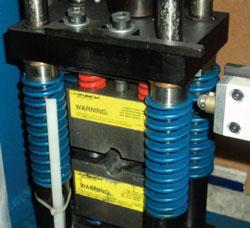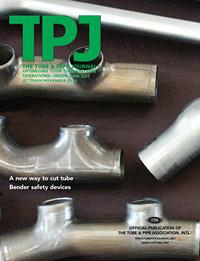- FMA
- The Fabricator
- FABTECH
- Canadian Metalworking
Categories
- Additive Manufacturing
- Aluminum Welding
- Arc Welding
- Assembly and Joining
- Automation and Robotics
- Bending and Forming
- Consumables
- Cutting and Weld Prep
- Electric Vehicles
- En Español
- Finishing
- Hydroforming
- Laser Cutting
- Laser Welding
- Machining
- Manufacturing Software
- Materials Handling
- Metals/Materials
- Oxyfuel Cutting
- Plasma Cutting
- Power Tools
- Punching and Other Holemaking
- Roll Forming
- Safety
- Sawing
- Shearing
- Shop Management
- Testing and Measuring
- Tube and Pipe Fabrication
- Tube and Pipe Production
- Waterjet Cutting
Industry Directory
Webcasts
Podcasts
FAB 40
Advertise
Subscribe
Account Login
Search
Sizing up the job
One size doesn’t fit all when considering quoting strategies
- By George Winton
- November 1, 2010
- Article
- Shop Management
Putting a price on a fabricated tube is something we all deal with, and it’s critical to keep in mind the many factors that can come into play when we are asked to quote a job. Some are so obvious we tend to gloss right over them, and some are not so obvious. The difference between getting a quote right, so both parties are satisfied, and misquoting a contract often is separated by a fine line.
Bottom Up
The bottom-up approach is one of the more common. Add up the cost of goods sold (COGS) and then apply a multiplier to the COGS that covers the overhead and includes a modest profit. The COGS may include raw tubing, plating, fittings, direct labor, and tooling, but the list can go on. Fabricators often have a spreadsheet program that helps them quickly build a financial picture of the COGS.
The multiplier itself is market-dependent. Multipliers in the tube fabrication industry can range from 1.2 to more than 5. It just depends on the specifics. For example, the market is crowded with fabricators that can handle a simple single-bend part, so competition may drive the multiplier down below 2. In contrast, a six-bend part that has compound bends may not get many bidders. Some fabricators simply don’t want to quote a compound-bend part because it can bring on complexities that many fabricators aren’t familiar with and don’t want to deal with. Such a quote is less competitive, allowing a larger multiplier.
Another factor that affects the multiplier is existing overhead. If it already has the right equipment, a smaller company—one with lower overhead costs—may be able to quote with a lower multiplier while at the same time realizing a respectable profit.
Overhead itself often takes into account salaries, insurance premiums, rent, utilities, and other indirect costs. One component of overhead may be research and development. This component is part of the pricing structure of many companies that use strategic planning for long-term success.
Another variation of the bottom-up approach is to cost the job according to time and material. Time is labor at a certain dollar rate, and the cost of materials is passed on to the customer. Straightforward and simple. This approach tends to prevail when the bidder is surrounded by stiff competition. In this approach, the labor dollar rate should include the overhead.
Top Down
The top-down approach is a completely different perspective. It asks this question: What is the part worth to the market? Sometimes the market is willing to pay much more than the costs associated with time and material. At other times the market is not willing to cover even the local COGS. In these cases, the market often seeks out foreign suppliers that have lower COGS. On the other hand, the challenges associated with making the tubular part may drive the market. For example, a load of fabricated tubular parts may be expensive to ship 300 miles via common carrier and so a local supplier gets a leg up. Parts that are awkward to ship via common carrier also help local suppliers.
The top-down approach is sometimes considered by a bidder when a buyer makes the current pricing known. In this case, the bidder is able to evaluate his COGS and then compare it to the current price. This has advantages and disadvantages. The fabricator might get more profit than otherwise, but if the price is too high, he’s vulnerable to another fabricator undercutting his price slightly.
The proper pricing strategy is market-dependent. It’s that simple.
About the Author

George Winton
3644 Burnette Road
Suwanee, GA 30024
888-321-1499
About the Publication
Related Companies
subscribe now

The Tube and Pipe Journal became the first magazine dedicated to serving the metal tube and pipe industry in 1990. Today, it remains the only North American publication devoted to this industry, and it has become the most trusted source of information for tube and pipe professionals.
start your free subscription- Stay connected from anywhere

Easily access valuable industry resources now with full access to the digital edition of The Fabricator.

Easily access valuable industry resources now with full access to the digital edition of The Welder.

Easily access valuable industry resources now with full access to the digital edition of The Tube and Pipe Journal.
- Podcasting
- Podcast:
- The Fabricator Podcast
- Published:
- 04/16/2024
- Running Time:
- 63:29
In this episode of The Fabricator Podcast, Caleb Chamberlain, co-founder and CEO of OSH Cut, discusses his company’s...
- Trending Articles
Zekelman Industries to invest $120 million in Arkansas expansion

3D laser tube cutting system available in 3, 4, or 5 kW

Corrosion-inhibiting coating can be peeled off after use

Brushless copper tubing cutter adjusts to ODs up to 2-1/8 in.

HGG Profiling Equipment names area sales manager

- Industry Events
16th Annual Safety Conference
- April 30 - May 1, 2024
- Elgin,
Pipe and Tube Conference
- May 21 - 22, 2024
- Omaha, NE
World-Class Roll Forming Workshop
- June 5 - 6, 2024
- Louisville, KY
Advanced Laser Application Workshop
- June 25 - 27, 2024
- Novi, MI



























